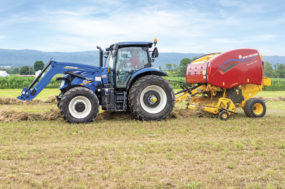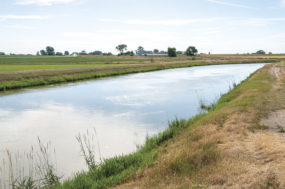Strange thing is, the older I get the more fellows I see who are taller than I am. I’m by no means a giant – I only stand 6 feet, 4 inches tall. I wonder how the guys who make me feel like a runt get by trying to find clothes that fit?
Ed Woodby comes to mind. He’s noticeably taller and somewhat heavier than I am, and guess what? I see a discreet “Cabela’s” logo on lots of his clothing.
Cabela’s also carries a folding director’s chair meant for camping that comes in two sizes – regular and six inches taller from the seating area to the ground. When I’m ready to buy and need something that fits me, guess where I look first? The places that make it a practice to have available, if not in stock, things that actually fit me.
Have you ever asked the people you sell hay and forage to what it is they have a real [tough] time locating? The answer “good hay that’s cheap” does not qualify as a reasonable answer.
Back when I was seeing the Northwest through the windshield of a Freightliner hay truck, on occasion I stumbled upon just the hay I was looking for by accident. When hay got short in the usual areas, I would extend my travels searching for hay. Many times when I found real milk cow alfalfa in new-to-me places, I made it a point to stay in touch with the grower early in the next crop year.
Too many times I found that the nice milk cow hay had been an accident. The grower did not know what happened to make his hay of the previous year green and leafy, soft and tender and baled with just the right amount of dew moisture to hold all the leaves on the stem as it was baled.
I visited one of these places the next year at haying time; they had the baler crew out in full force in the middle of a hot, dry day baling up hay that was both too wet and too dry at the same time.
The leaves were shattering and falling to the ground when the balers picked up the windrow, and the stems of the alfalfa were still green. I may as well have been speaking Greek to the grower about what kind of hay I needed and how what he was doing to his hay made it totally unusable to my customers.
There will be some variation from year to year on what types of hay are in short or long supply. There are, however, some constants. Ask the people you sell to what they have the most trouble finding most years. If the answer is feed store hay, ask which kind. In one area the feed store hay that is short is second-cutting orchardgrass hay.
When the price of oil and fertilizer shot to the moon in 2008, fewer growers who had the option of other crops stayed with orchardgrass hay. To get a decent second and third cutting, it had to be fertilized heavily between cuttings and the price of the hay would not cover the inflated cost of the fertilizer. What to do? Talk to the people who have been pleasant to do business with over the years and ask what it would take to make orchardgrass hay a winning crop for both of you.
Note that feed store hay is generally purchased by the ton and sold by the bale. The norm has been for hay haulers to whine about two-tie bales that are less than 100 pounds each.
If the hay is orchardgrass and bound for a feed store, a solid bale that weighs 80 to 85 pounds is just the ticket. A professional hay hauler set up with belly trailers in the state of Washington can haul around 750 bales that are 16 inches by 18 inches by 46 inches. That means he can haul more bales per load that are lighter and still have a full legal weight load.
When offered to the owner of a feed store, the price that matters is not the price per ton but the price per bale. This translates into dollars and cents like this: hay going to a feed store can be purchased for more per ton if the bales are lighter.
If the price differential to afford the fertilizer is $15 per ton, you may be able to get it by adjusting the weight of the bale and letting the buyer who is desperate for orchardgrass hay know what you are doing.
One operation I’m close to converted to 3x4 big bales a few years back from two-tie small bales – except for second- and third-cutting orchardgrass and second-cutting timothy.
The fellow they had been supplying with feed store hay needed these commodities. When they sat down and talked over the needs and the money issues, they made it work. Making it work as it has for these two parties, for many years now, requires trust and honor on both sides.
If the buyers you deal with most are servicing dairies, have them ask the dairymen about the mineral content of the hay they receive. For cows close to calving, the mineral balance needs to be watched closely.
Hay with a low potassium content is a must to keep cows healthy after calving to rejoin the milking herd. The potassium content of hay is a function of the make-up of the soil where it is grown and the fertilizer applied.
Some research here with the input from the dairy and from the fertilizer company may create a lucrative niche market for some of your hay dairies are begging for. Most of the time, low-potassium hay is discovered by accident. If you can grow it on purpose, you have a winner.
Exporters have a number of niches that can be difficult to fill. Making the end users happy overseas is most often a moving target. There are constants, some of which are clean of weeds, with an absolute prohibition on wheat, barley, straw from either, and quack-grass.
It needs to be free of dirt, nice and green. There are area-specific requirements that have to do with stem-size and packaging.
First cutting that is between 20 and 22 percent crude protein and between 155 and 180 relative feed value (RFV) and with a large stem that is hollow, flat and soft is the normal request for premium dairy alfalfa for export to Japan.
Some areas are hung up on green color, while some actually prefer a more pale green color, almost bleachy. If you know what drives the export hay buyers crazy trying to find, you may open the door for yourself on a valuable niche market.
The world market on oat hay has a lot to do with how much rain falls on western Australia. The world market on timothy hay has a lot to do with how severe the current drought is in western Canada. Understanding this can add to the things you look at when you decide how many acres of oat hay and timothy you will plant.
Once you find out what your hay buyers are looking for, do some homework and see if some of it could be grown on your farm. If it is new to you, get the guys who want the crop to show you how to put it up at harvest so it is like they want it to be.
You don’t have to put the whole farm into a new crop. Perhaps the hay buyer will need to locate a dependable source for “two or three loads of brome grass a year,” or some other different grass that they need just a little of. Matua grass and teff grass are two that I hear people looking for just a load or two of every now and again.
If a different forage crop will fit into your operation but you have no idea where to market it, do some research. Unless you have some fabulous mutant seed on hand that no one else has ever had before, you will be able to find someone somewhere who is growing what you are looking at growing.
They will be doing something with it that may work in your area. It would be wise to develop relationships with those you sell forage to, so they feel comfortable coming to you and asking what it would take for you to grow a specific crop for them. Let your hay and forage buyers know that when they need something out of the ordinary, your farm is the place that will grow it for them. FG











